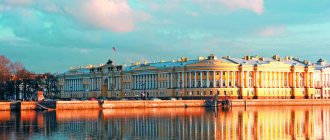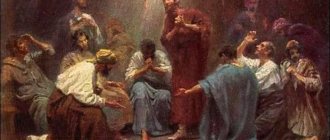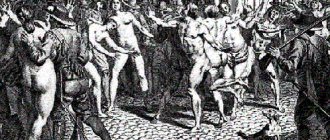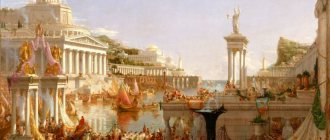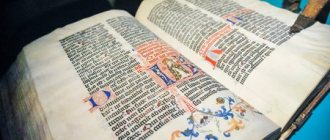UNION OF LYON
After K-pol was occupied by the troops of the Nicaean Empire (July 25, 1261), and Lat. imp. Baldwin II (1240-1273) and lat. Patriarch K-pol Pantaleone Giustiniani (1253-1286) fled from the city, Byzantium established itself in power. Palaiologan dynasty. Its founder was the Nicene emperor. Michael VIII Palaiologos was re-crowned as Emperor of the revived Byzantine Empire at St. Sophia (15 Aug. 1261). By this time the power of the Byzantines. the emperor was weakened by a number of internal and external factors, primarily the incessant attempts by the West. aristocracy to restore the Latin Empire.
Imp. Baldwin II, originally located on the island of Euboea, soon met with cor. Sicily by Manfred (1258-1266), and then visited Venice and Rome, where he found support for the Papal throne. Immediately after imp. Coronation of Michael VIII, Pope Urban IV (1261-1264) began preaching a new crusade, the goals of which were the reconquest of K-field and the restoration of Baldwin II to the throne, but most of the West. chivalry did not respond to this call. The only ruler interested in the expedition was Manfred, cor. Sicily. Back in 1257/58, he entered into an alliance with the despot of Epirus, Michael II Comnenus Ducas (c. 1230-1266/68), as well as with the ruler of the Achaean (Moray) principality, Guillaume II Villehardouin (1246-1278) against the Nicaean Empire; On June 2, 1259, Manfred married the daughter of Michael II.
In the Battle of Pelagonia (September 1259), the troops of the Principality of Morea and the Despotate of Epirus were defeated, Prince. Guillaume II is captured. Imp. Michael VIII promised him freedom in exchange for the return of Byzantium to the South. Peloponnese, and in 1261 the prince solemnly promised to hand over Mystras and Monemvasia to the emperor, and also became the successor of one of the sons of Michael VIII. The restoration of Byzantine control over these territories could become the basis for the gradual reconquest of the Byzantines. army of lands occupied by Latins, Bulgarians and Serbs. To prevent such a situation, Pope Urban IV, after some time, released Guillaume II from the oath given to the Byzantines. to the emperor.
A significant part of Italy was under the control of the Sicilian king, but the pontiff did not want to see Manfred at the head of the crusader army, since he was the illegitimate son of the emperor. Frederick II Staufen (1220-1250), led the Italian party. Ghibellines (supporters of the emperor in opposition to the Pope), and also entered into conflicts with Popes Innocent IV (1243-1254) and Alexander IV (1254-1261). Realizing the advantageous geographical position of Sicily as a springboard for Bud. expedition against Byzantium, the pope was looking for a ruler capable of overthrowing Manfred. As a result, the choice fell on Charles I of Anjou, brother of the French. cor. Louis IX Saint.
In 1262, Pope Urban IV began negotiations with the French. court, inviting Charles of Anjou to take the throne of the Kingdom of Sicily. According to the terms of the agreement concluded in June 1263, many were imposed on Charles. restrictions: he could not control appointments to church posts, could not claim imp. throne and occupy k.-l. post in the imperial part of Italy and in the Papal region, but in the fall he was elected senator of Rome, which was a violation of the treaty. After negotiations, both sides agreed to concessions. Elected to the Papal throne after the death of Urban IV, Pope Clement IV (1265-1268) continued the policies of his predecessor and on June 28, 1265 in Rome, proclaimed Charles King of Sicily.
Manfred, having gathered an army, marched against Charles of Anjou. After a small skirmish, Manfred was forced to retreat, as a result of which he lost power in the March of Ancona and his influence in Tuscany weakened. Charles of Anjou, through the mediation of the pope, collected the money that was necessary for the campaign against Manfred. In Oct. The army he recruited set out from Lyon and in January. 1266 arrived in Rome. 6 Jan Charles was crowned King of Sicily in Rome. basilica of st. Petra, 20 Jan. with his entire army he marched against Manfred. 26 Feb. in the battle of Benevento, Manfred’s army was defeated and he himself was killed. On March 7, Charles of Anjou solemnly entered Naples. However, only after the victory on August 23. 1268 at Tagliacozzo over Manfred's nephew Conradin, Hertz. Swabia and titular cor. Jerusalem (1254-1268), and his execution (Oct. 29, 1268), the new king of Sicily was able to begin implementing plans to create a large empire in the East. By this time, the island of Kerkyra (Corfu) and the eastern coast of the Ionian Sea - from Dyrrhachium (now Durres, Albania) to Butrint - were also under his control. May 24, 1267 Prince. Guillaume II Villehardouin gave Charles of Anjou the right to rule the Achaean principality after his death; On May 27, this decision was confirmed by Lat. imp. Baldwin II. After the death of Pope Clement IV (November 29, 1268), Charles of Anjou concluded treaties with the rulers of Hungary, Serbia and Bulgaria. However, the king's plans to expand his possessions were prevented by the promise to participate in the 8th Crusade, organized by Cor. Louis IX (see Art. Crusades).
In 1268, Emperor. Michael VIII Palaiologos, trying to prevent the aggressive plans of Charles of Anjou, sent an embassy, the purpose of which was to conclude an alliance with the Serbian cor. Stephen I Urosh (1243-1276). The union was planned to be sealed by the dynastic marriage of the Byzantine daughter. Emperor Anna and Tsarevich Milutin (later cor. Stefan Urosh II Milutin). After the unsuccessful embassy, Michael VIII began to consider negotiations with the Papal See on church union as the only way to prevent a war with Charles of Anjou. Since the negotiations were complicated by the fact that the Roman See remained vacant for a long time, Michael VIII sent an embassy to the French court. cor. Louis IX Saint. Byzantine. the embassy arrived in France in the summer of 1269. In a letter dated May 15, 1270, the College of Cardinals addressed Raoul de Groparmy, card.-bishop. Albano, responsible for preaching the 8th Crusade, was informed that the imp. Michael VIII declared the French. to the king about the desire of both himself and his subjects and clergy “to return to the obedience of the Roman Church and to unite in the profession of the same faith.” Louis IX replied that the resolution of this issue was within the competence of the College of Cardinals. The letter also mentioned attempts to restore the unity of the Church, undertaken under Popes Urban IV and Clement IV, and also spoke of a mandatory condition for achieving this unity - the confession of true Catholicism. faith (verae catholicae fidei professio). After the approval of the Catholic Confessions at the Council of the Polish Byzantine Church. the emperor, the Patriarch of Poland and other bishops, archimandrites, as well as representatives of the clergy and laity had to recognize the primacy of the Roman Church (Acta Urbani IV, Clementis IV, Gregorii X (1261-1276) / Ed. A. Tăutu. Vat., 1953. N 29. P. 78-84). Dr. The cardinals sent a letter to cor. Louis IX. Expressing hope for the speedy conclusion of a union, they warned the French. king from “Greek tricks” (Ibid. N 29a. P. 84-85).
Imp. Michael VIII sent the 2nd embassy to Louis IX, who was in Tunisia, headed by the court archdeacon. Konstantin Meliteniot and led. Chartophylax diac. John Vekkos (later Patriarch of Poland John XI Vekkos). Arriving at the site of ancient Carthage, the ambassadors found the French. the king already dying (Georg. Pachym. Hist. V 9).
World. Human. Word.
After the break in relations between the Western and Eastern Churches, attempts to reconcile them arose more than once. However, the main stumbling block was the question of the primacy of the Roman bishop. If for the East the primacy of the Roman see remained a moral concept and was based on church tradition, then the West perceived the primacy legally. The peoples of the Western Empire were little inclined towards contemplative theology, as was the case in the East. They were the creators of Roman law and a strict state system, therefore they perceived Christianity as a system of social order necessary for salvation. The Eastern Church recognized the primacy of honor for the pope, but not superiority over other Churches. The Bishop of Rome believed that the final decision on any question of faith rested with him. The Byzantine bishops were convinced that this decision should belong to the council of all bishops of the Church. The capture of the capital of the Eastern Empire by the Crusaders at the beginning of the 13th century led to the final rupture of the Eastern and Western Churches. After this, attempts were made to unite the two branches of Christianity through union.
The word union translated from Latin means unity. In practical terms, this meant the merger of the Catholic Church with the Orthodox Church on the terms of recognition of the primacy of the Pope. The Roman high priests did not lose hope of subjugating the Orthodox Church to their power. It was for these purposes that the union was conceived. The Union simplified the transition of Christians from Orthodoxy to Catholicism, since Orthodox rites and worship remained unchanged, and ordinary Christians often did not delve into doctrinal issues. The interest in the union of the Byzantines was purely political. The position of the Eastern Empire was extremely difficult, and in order to protect the state from the invasions of Western rulers, the support of the pope was required.
The first such attempt to unite two Churches was the Union of Lyons. Having recaptured Constantinople in 1261, Emperor Michael Palaiologos restored the Byzantine Empire. However, during Western rule, the former greatness of Byzantium was lost. Latin emperors were constantly on the verge of bankruptcy and sold everything that was on sale. Churches were devastated, palaces were destroyed; even the lead from the roofs of the imperial palace was stripped and sold. The new emperor needed huge funds not only to restore what had been lost, but also to defend the conquered empire. Help could only be expected from the pope at the cost of uniting the Churches under the rule of Rome.
As a result of negotiations, Emperor Michael agreed to subordinate the Church of Constantinople to the papal throne despite the resistance of the clergy and people. In 1274 the pope convened a council in Lyon. The delegation representing the Church of Constantinople was extremely unrepresentative and was headed by the deposed Patriarch Herman. But the pope was represented by a whole host of famous theologians. However, there were no theological debates at the council. The Constantinople delegation brought with them a letter from the emperor agreeing to all the conditions of the papacy. Thus, the Church of Constantinople formally entered into a union with the Roman throne.
However, it soon became obvious that it was much easier for the emperor to accept the papal conditions than to impose them on the Church and the people. Almost the entire empire rejected the union. Patriarch Joseph excommunicated the emperor from the Church. However, the emperor remained faithful to the union he signed and used the full power of the state machine to impose it on the people. The emperor managed to depose the patriarch. Many bishops, priests and monks who refused to accept the union were exiled, thrown into prison and tortured. The emperor tried to impose the union through persuasion, explaining its political necessity. But he was powerless. Union supporters served in empty churches. The emperor’s sister, declaring that “it would be better for my brother’s empire to perish than the Orthodox faith,” retired to the court of the Bulgarian Tsar.
Five papal embassies that visited Constantinople reported to the pope that the Orthodox Church did not actually accept the union. In 1281, the new Pope Martin IV broke his alliance with Michael and excommunicated him. A year later, with the death of Emperor Michael Palaiologos, the Union of Lyons ended.
Having saved the Byzantine Empire, remaining faithful to the union until the end of his life, twice excommunicated from the Church, Emperor Michael Palaiologos was left without church burial.
Having ascended the throne, his son Andronikos II convened a council in Constantinople, at which the Union of Lyons was condemned and rejected. After this council, the renunciation of the union was confirmed twice more at councils. The first attempt to artificially unite the Western and Eastern Churches never succeeded.
Attractions
Astronomical clock
The working astronomical clock located in the cathedral is the oldest in France. They trace their history back to the 14th century. After destruction by the Huguenots, they were restored from 1572 to 1600. They acquired their baroque appearance in 1655. In the 18th century, a minute dial with an arrow appeared on them. Despite numerous repairs and alterations, the clock contains some iron parts smelted at the end of the 16th century.
Shows hours, minutes, date, position of the Moon and Sun relative to the Earth, as well as the rise of the brightest stars over Lyon.
Four times during the day (at 12, 14, 15 and 16 hours) the clock rings, accompanied by the movement of automatic dolls located at the top of the clock and depicting scenes on religious themes.
LYON CATHEDRALS
LYON CATHEDRAL 1245 and 1274, Roman Catholic cathedrals. churches (in the Catholic tradition since the 16th century, they are considered the XIII and XIV Ecumenical Councils, respectively), held in Lyon.
I L. p. (26.6–17.7.1245) convened by Pope Innocent IV, who fled to Lyon from Rome, besieged by the troops of the emperor. Frederick II. Approx. took part in the work of the cathedral. 150 bishops, including Lat. patriarchs of Constantinople and Antioch, a large number of clergy and laity. Among the participants in the cathedral, sources mention a certain “Archbishop of Rus'” Peter, possibly an envoy of the Chernigov prince. Mikhail Vsevolodovich abbot Pyotr Akerovich, who laid claim to the Kyiv department. Basic place in work I L. p. took over the trial of Frederick II on charges of heresy and persecution of the Church. The emperor, who refused to appear at the council, was anathematized on July 17, 1245 and removed from the throne. The Council also discussed plans to help the Latin Empire in the war with the Nicene emperor. John III Ducas Vatatz, organizing crusades to liberate Jerusalem and against the Mongols. The resolutions of the cathedral include 22 canons dedicated to various matters. canonical issues law and church proceedings, as well as the protection of church property.
II L. p. (7.5–17.7.1274) convened by Pope Gregory X (1272–76) with the aim of concluding a church union with the Orthodox churches, organizing a crusade to the Holy Land and renewing the moral life of the clergy and laity. More than 500 bishops, 60 abbots and approx. took part in the work of the cathedral. 1000 other clergy (including famous theologians Albertus Magnus and Bonaventure). Byzantine. imp. Michael VIII Palaiologos, who tried to enlist the support of the pope in the fight against the King of Naples and Sicily, Charles I of Anjou, sent an embassy to the cathedral headed by Vel. logothete George Acropolitus, but because of the shipwreck of the Byzantine Empire. The delegation arrived in Lyon only on June 24, 1274. At the cathedral, messages from the emperor were read. Michael VIII and the Byzantines. clergy, which recognized the primacy of the Pope and the doctrine of the Roman Catholic. churches. In a letter to the imp. Michael also contained a request to allow Greek. The Church retains the Creed without the Filioque. At the 4th meeting of the council (6.7.1274), George Acropolis, on behalf of the emperor, took a solemn oath, which affirmed the supremacy of the pope in the Christian Church, and signed the union of the West. and Vost. churches (Union of Lyons). After this, the Creed in Greek was read during the liturgy. language with the addition of Filioque. Resolutions II L. p. include 31 canons, 3 of which were added by Gregory X after the end of the council. The 1st canon set out the Catholic the doctrine of the eternal procession of the Holy Spirit from the Father and the Son from one beginning (ex uno principio). Dr. the canons regulated the rules for holding a conclave, the procedures for electing bishops and ordaining priests, and considered various matters. issues of church discipline, and also abolished those that arose in the 13th century. monastic orders, except for the Franciscan and Dominican orders. To prepare for the crusade, the cathedral introduced tithes on all church income for 6 years.
The Union of Lyons was not accepted by most of the Byzantines. society. Serbia, Bulgaria, Epirus and the Empire of Trebizond also refused to recognize it. The Union was officially broken by the son of Michael VIII, Emperor. Andronicus II Palaiologos (1282).
Section II. Third period of Christian history (1054–1453)
Bogomil heresy
stands in close connection with the Paulician heresy 14. The Byzantine government, in order to weaken Paulicianism, resettled a significant part of the heretics from Armenia to Thrace. Here Paulicianism took deep roots and, under the influence of new conditions, developed into a special heretical system, called Bogomilism. Bogomilism spread with particular force in the 11th–12th centuries. In Bulgaria. The name Bogomils comes from the words: “God and have mercy” or “Dear God.” But more accurately, when elucidating the etymology of the word, one must proceed from a certain Bogomil, who, if not the first founder of the Bogomil teaching, was its most decisive disseminator in Bulgaria. Because of the obvious connection between the Bogomils and the Paulicians, they were called Paulicians and Armenians, as well as Manichaeans, due to the similarity of their teaching in some points with the teaching of these ancient heretics. The basis of the teachings of the Bogomils is dualism - the recognition of two principles in the world: good and evil. But some Bogomils accepted dualism in a softened form, considering the evil principle to be a good angel who had fallen away from God, others adhered to absolute dualism, recognizing the evil principle as existing from eternity.
The Bogomil teaching about the universe can be reduced to the following provisions. There are two Gods - creators: good and evil. The spiritual and material worlds owe their origin to them. The good God created the spiritual angelic world: the unsettled invisible earth or primeval chaos. At the head of the angelic spiritual world was the firstborn son of the good God, Satanail. Proud of his dignity, he rebelled against the Father and seduced some of the angels subordinate to him. For this he was cast out of heaven. From the primeval formless chaos he created this visible world and created the human body. All his attempts to revive the human body and breathe into it the breath of life were unsuccessful. Then he asked his Heavenly Father to send his divine spirit to revive the human body he had created. At the same time, he promised that people with their spiritual nature would replenish the number of fallen angels, and he himself would rule over the bodily nature of man. Heavenly Father sent his breath and revived Adam's body. Eve was created in the same way.
But Satanail betrayed his promise and decided to take possession of a completely human and spiritual substance and distract man from his Heavenly Father. He entered into the serpent and seduced Eve. The fruit of this temptation was the offspring of Satanail in the person of Cain and his sister Kolomena. Abel appeared as a representative of the good offspring of Adam, but he was killed by Cain. Just as the good son of Adam perished from the evil descendant of Satanael, so everything good and spiritual in humanity had to perish from the plans of Satanael. And Satanael, indeed, enslaved all of humanity to himself. He ruled over people until the coming of Christ throughout the Old Testament. The Old Testament law aimed at enslaving people was the work of Satanael. In this denial of the significance of the Old Testament revelation as a preparatory stage for the New Testament, the Bogomils agree with the Gnostics of the Syrian trend.
In order to crush the power of Satanael and save people from his power, the Heavenly Father, 5500 years after the creation of the world, belched out from his heart the divine word, another Son, Jesus, who, as the chief of the good angels, also bore the name Michael. The Word came down from heaven, entered the right ear of the Virgin and also came out of her, and appeared in the form of a man, although without a human body. The whole life and deeds of Christ were illusory. Satanail did not recognize his opponent in the face of Christ and entered into a struggle with him, as with a person who was harming his dominion over the world, he aroused the anger of people against him and brought him to death. But Jesus rose again and in all his divine majesty appeared to Satanael, chained him and took away from him the remnants of divine power and power contained in the final syllable of his name “il.”
Having transformed from Satanail to Satan, he was imprisoned in Tartarus. After the ascension of Christ into heaven, God, to complete the salvation of people, produced from himself a second force - the Holy Spirit. The final process of world life will be the liberation of everything spiritual from the carnal and material. Human souls will take their place in the kingdom of the Heavenly Father. Everything material will again turn into chaos. Jesus and the Holy Spirit will lose their separate existence and merge with God the Father.
Denying and condemning everything of the Old Testament, the Bogomils did not recognize the New Testament Church. It seemed to them a carnal institution, dominated by Satan; they rejected church teaching, the Sacraments, hierarchy, veneration of the cross, icons, relics, invocation of the Mother of God, saints in prayers and, in general, all church rituals. Divine services were considered verbose and only one Lord's Prayer was recognized. Holidays of the Orthodox Church were not recognized, but they observed fasts, fasting on Monday, Wednesday and Fridays, their hierarchy consisted of teachers and apostles: in each community there was a teacher and with him 12 apostles.
The moral teaching of the Bogomils was distinguished by a severely ascetic character. Since everything earthly and material, including the human body, is the creation of Satan, they taught to withdraw from the world with all its delights and to exhaust the body through various feats of abstinence. They prohibited wine, meat and marriage. The killing of humans and even of any animal, except snakes, the devil's animals, was absolutely forbidden, and therefore they completely denied war; Equally, oaths and any testimony in court were not allowed. These requirements were observed especially strictly by active members of the sect compared to ordinary believers. For ordinary believers, concessions were made: they could marry, own property, and participate in war. The Bogomils recognized the Holy Scripture of the New Testament as the source of their doctrine, but interpreted it allegorically, in relation to their doctrine. In addition, the Bogomils distributed their literature mainly of an apocryphal nature.
The Bogomil heresy from Bulgaria, as its center, quickly spread to other countries. At the beginning of the 12th century, its strong nest was discovered in Constantinople, not only among the laity, but also among the clergy. The heresy penetrated even into aristocratic circles and spread secretly. Emperor Alexius Komnenos was concerned about this. He managed to find out that the head of the heretics was a certain monk Vasily, who had previously been a doctor. The emperor, with special intent, invited him to the palace, showed him honors, seated him at his table and revealed to him his intention to move to the society founded by Vasily. Vasily confidentially informed the emperor everything concerning the Bogomils. Meanwhile, the emperor placed a shorthand secretary behind the curtain, who recorded all of Vasily’s speeches in the protocol. As soon as Vasily finished giving his testimony, to his surprise, the curtain rose, and a whole meeting of the highest clergy and secular persons of the capital was presented to his eyes, and his trial began. Vasily did not retract his words and was thrown into prison.
During the investigation, many people from all classes were convicted. Of those arrested, some admitted that they really belonged to the heresy, others refused to confirm their involvement in the sect. To separate the guilty from the innocent, the emperor used the following trick. He ordered everyone who did not confess to heresy to be taken to the open square. Two fires were built here. A large cross was placed over one of them. The accused were informed of the decision to burn them all, due to the impossibility of distinguishing Orthodox from heretics. Those who wish to die Orthodox must approach the fire over which the cross is placed. When the convicts were divided into two parties, it became clear to the emperor which of the convicts really belonged to the heretical party. These latter were again imprisoned. Only Vasily was burned.
However, these measures did not destroy the heresy, although its open propaganda in the East was suspended. Secretly, in separate remote monasteries and monasteries, the Bogomil sect continued to exist. It is known that in the 13th century, Patriarch Germanus II (1222–1240) in his conversations rebelled against the Bogomil opinions that still existed in the Church of Constantinople. After the persecution of the Bogomils began, her followers from Bulgaria partially penetrated into Russia.
